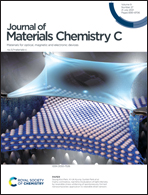Insight into the aggregation prospective of Schiff base AIEgens enabling an efficient hydrazine sensor in their aggregated state†
Abstract
In this study, we present two small fluorogenic Schiff base molecules 1 and 2 encompassing both donor and acceptor moieties, respectively, in the single-molecule to trigger the AIE activity and report their aggregation behavior through in-depth spectroscopic and microscopic analysis. Both 1 and 2 can act as a potential AIE luminogen by tuning the water content of the acetonitrile medium. Subsequently, in their aggregated state, they can act as an efficient hydrazine sensor due to a remarkable selective turn-on fluorescence response towards hydrazine in 1 : 1 acetonitrile–water medium. The detection limits (LODs) for hydrazine were calculated to be 0.5 ppb and 0.4 ppb for 1 and 2, respectively. The sensing phenomenon can be attributed to the hydrogen bonding-induced disaggregation phenomenon of AIEgen aggregates. Moreover, the sensing aptitude of AIEgens 1 and 2 to discriminate hydrazine in the vapor phase and various water samples and fluorescence bio-imaging studies highlights the analytical merit of AIEgens in practical applications.



 Please wait while we load your content...
Please wait while we load your content...